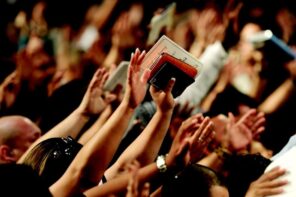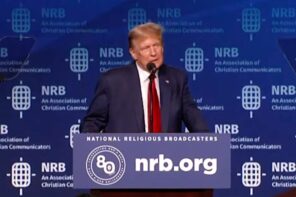Conservative Christians have long seen the Walt Disney Company as an enemy in the culture war. In 1997, the Southern Baptist Convention launched an eight-year boycott over the company’s supposed promotion of “homosexuality, infidelity, and adultery.” The appearance of gay characters in films like Beauty and the Beast (2017) and Onward (2020) has sparked more recent outcries.
So it was no surprise when Jonathan VanBoskerck, a self-described “Christian and a conservative Republican,” threatened to stop visiting Walt Disney World (WDW) because “wokeness” was “ruining the experience.” Like many earlier critics, VanBoskerck accused the company of abandoning the “values and vision of Walt Disney” and giving in to liberal political demands. VanBoskerck points to several changes to the theme parks Disney has recently made or announced: allowing Cast Members (employees) to display tattoos and earrings, removing a racist character from the Jungle Cruise, removing a scene depicting sexual violence from Pirates of the Caribbean, and retheming Splash Mountain after The Princess and the Frog (2009) rather than the racist 1946 film Song of the South.
Disney cultivates loyal theme park visitors like VanBoskerck by presenting WDW as a refuge from the real world, a literal fantasyland in which all your dreams come true. Within this fantasy, you—the capital-G Guest—are the star of the show, evil is clearly defined and easily defeated, and the past is celebrated as a source of comfort and inspiration. And while this ideology makes for happy guests and healthy profits, it also has deep affinities with the worldview that white evangelical Christians in America have been constructing for decades.
Walt Disney first conceived of his theme parks as interactive, life-sized movies in which guests assumed the roles of animated heroes like Snow White, Pinocchio, and Peter Pan. Ever since, it’s been Cast Members’ chief responsibility to treat every guest like they’re the most important person there. You might wait two hours to meet Frozen’s Anna and Elsa, but once you step inside their palace, they’ll act like your kids are the only ones they’ve seen all day.

A sheet of Disney Villain postage stamps consisting entirely of women, creatures, and swarthy men.
Of course, for every princess there’s a villain. Thankfully, Disney villains are easy to spot: just listen for ominous music and an evil laugh. And thanks to unambiguously good characters like Mickey Mouse and Jiminy Cricket (who reminds us that “if your heart is in your dreams, no request is too extreme”), these villains—a disproportionate number of whom are women or nonhuman—don’t stand a chance.
But good doesn’t only triumph against witches and monsters. Disney’s wish-upon-a-star worldview also means that guests can indulge in nostalgia for the past without wrestling with any of history’s ugliness. The Magic Kingdom’s Adventureland offers river cruises through 1950s Africa without any mention of colonialism, for example, and Frontierland welcomes guests to a mythical Wild West that leaves out Manifest Destiny and anti-Indigenous violence. When something unsavory does appear, like pirates pillaging a town, it’s passed off as a harmless joke—just part of the fantasy.
This Disney ideology has plenty of problems: scholars and activists have criticized it for its individualism, its American exceptionalism, its patriarchy, and its white supremacy, among other things. For many Disney guests, though, living in this fantasyland for a few days remains a refreshing break from the anxieties and ambiguities of everyday life. Having believed in magic for a few days, they return to a world where they’re not center stage, where morality is messy and history is fraught.
But not white evangelicals. They don’t need to fully disengage from the fantasy because their own worldview resembles it so closely. In fact, it’s not dissimilar to the one Peter Laarman recently laid out here on RD, which he called “the still-potent religion of American Innocence.” Of course, most evangelicals don’t literally believe in pixie dust and fairies, but they do think of themselves as the protagonists of history, draw clear lines between good and evil, and find inspiration in an uncomplicated, Disneyfied version of history.
Evangelicals’ impulse to cast themselves in starring roles can be quite literal. As Kristin Kobes Du Mez shows in Jesus and John Wayne, they’ve often adopted actual movie stars—not just John Wayne but also Mel Gibson and, of course, Ronald Reagan—as their models of righteousness. Or they remake history’s established heroes in their own image, as Eric Metaxas does in his much-criticized biography of Dietrich Bonhoeffer.
More generally, though, evangelicals believe that they’re more deserving of attention, freedom, and legal protection than other religious or cultural groups. They credit America’s success to its supposed Christian values and heritage, and support the presence of their own beliefs and practices in the public square. In 2016, nearly 80 percent of white evangelicals said Christians were discriminated against just as much as other groups. They want to feel like guests at Disney World: not just tolerated but affirmed and admired.
And evangelicals cast their own goodness against clearly defined evil. Satan, of course, is the most obvious villain: he’s a constant, active threat to Christian virtue. But evangelicals also see plenty of other bad guys scheming to take over the world, from “postmodernism” and “relativism” in the twentieth century to “critical race theory” and “cancel culture” today. For evangelicals, none of these villains have any redeeming qualities. They’re to be shunned and defeated, not negotiated with. In 1995, Robert Knight of the evangelical Family Research Council praised Disney for satisfying this evangelical desire for moral certainty: While the rest of Hollywood indulged in “moral relativism,” Disney offered a “clear delineation between good and evil.”
Some evangelicals also believe that villains can be slain by a kind of magic. The influential prosperity gospel preacher Norman Vincent Peale, for example, often sounded a lot like Walt Disney: “Imagination is the true magic carpet”; “Change your thoughts and you change the world.” For evangelicals in this tradition, the song from Cinderella is spot on: “Whatever you wish for, you keep.”
But another kind of Disneyfied thinking is even more widespread in evangelicalism: the desire to see the past as a golden age of moral uprightness. This tendency has extreme versions, like evangelical pastor Doug Wilson’s defense of the antebellum South. But it can also be seen in evangelical resistance to the 1619 Project, in hagiographies of twentieth-century missionaries to Africa and South America, and in nostalgia for the social norms of the 1950s.
These shared values explain why some evangelical Disney fans feel not just ignored but betrayed when Disney makes even the smallest changes. VanBoskerck laments the prospect of WDW being “taken away” from his family if he continues to “feel more and more excluded by Disney’s decisions.” He feels ownership over WDW as it’s always been, and any small change to make the parks more inclusive is therefore a threat to his own enjoyment.
John Hench, a longtime Disney artist and designer, once explained that “What we are selling is not escapism, but reassurance.” This is certainly true for white evangelicals, who have looked to WDW not only for family-friendly fun but also for affirmation of their own cultural attitudes. And if their feelings of affirmation start to fade, so does the magic.





